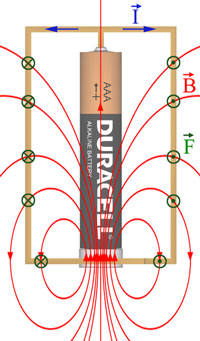13, Magnetism, electricity
Homopolar Motor & Electric train
Now you understand the basics of electricity, let’s also explore magnetism and motors.
You kit includes magnets to make a simple homopolar motor. These motors are great, but care must be taken. The batteries are dangerous if swallowed. Don’t leave them around small children.
Safety note: do not run your motor for more than a few seconds at a time. The wire may get hot if you let the motor run for too long.
Homopolar motor
This super simple motor has everything you need, to learn how electric motors work.
Equipment
From your science set take:
- 2 x 5mm diameter cylindrical neodymium magnet.
- 12 gauge bare copper wire
You'll also need
1 x AA battery Pliers (or similar). Method: Let's start with a simple version.
- Attach the 2 magnets to the bottom of the battery
- Take your battery.
- Wind the wire around the battery. It needs to be lose enough to turn freely
- Use your pliers to bend one end of the wire so that it will touch the top of the battery.
- Bend the other end so that it's touching the magnets.
- The wire should start to spin around the battery
What's happening

The copper wire connects the positive battery terminal to the magnet at the negative battery terminal, completing the circuit. Consequently, a current of electrons will flow through the wire.
Due to the close proximity of the magnet at the bottom of the battery, this current actually flows in the presence of a magnetic field. When current flows in a magnetic field, it'll experience a force — the Lorentz force — that acts perpendicular to both the current's direction and the direction of the magnetic field.
This force causes the wire to spin in a circle.
For extra credit you could try to make one of these:
There’s a lot of science in these very simple engines. Can you work it out?
Do some research and draw the current, magnetic field and force acting on the battery in the space below.